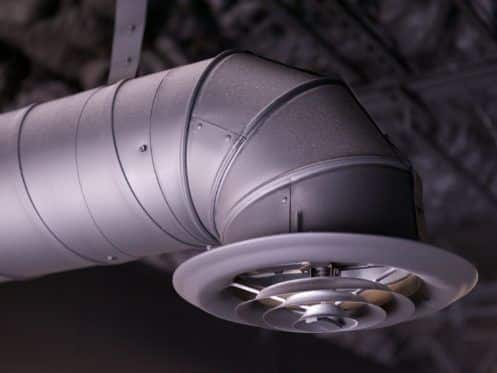Understanding How Ventilation Systems Work

Are you looking for ways to reduce your cooling and heating costs without negatively impacting your indoor comfort? Perhaps you have issues with your home always feeling muggy or your air always being stale and smelly? In any of these situations, the solution could be to upgrade your home or business with a mechanical ventilation system. To understand why this is, let’s take a closer look at how home ventilation systems work and the benefits that they can provide.
The Basics of Ventilation
Ventilation is quite simple. All it involves is bringing fresh air inside the home while at the same time drawing stale, polluted air back outside. Most older homes don’t have any issues with ventilation. This is because they tend to have many more small cracks and air leaks. Due to the pressure inside the home, air is constantly being drawn in from outside through some of the gaps, while air from inside is forced out through gaps on the opposite side of the home. This is useful for replenishing the fresh air in the home, however, it also greatly increases energy waste as it means your HVAC system will need to run more frequently.
You can also speed up the rate of ventilation by turning on the exhaust fan in your bathroom or kitchen. As the air is drawn out, it creates negative pressure in the home. This results in fresh air from outside rushing in through any cracks to balance out the pressure.
Why Proper Ventilation Is So Important
Ventilation is essential for homes and all other buildings. Without adequate ventilation, the air inside will quickly become filled with pollutants and contaminants. This creates major issues with poor indoor air quality and can lead to numerous short- and long-term health issues.
Ventilation is also important as the humidity level will quickly rise if you don’t have a way to vent air out from inside the building. The main reason is that people give off lots of heat and moisture. The more people there are in the building, the quicker the humidity level will rise. Plants and animals inside the building will also produce lots of moisture, The same is true for cooking, bathing and running your dishwasher. High humidity will make it so your air conditioning struggles to keep your home cool. If the humidity level rises high enough, you may also end up having issues with mold and mildew inside your home.
Types of Ventilation Systems
There are a number of different systems that can help ventilate your home. The most basic type is a whole-house fan. These are installed in your attic and connected through a vent in one of your ceilings. If you turn the fan on and open a window or door, stale air will be drawn up into your attic and blown out through an attic vent. This process creates negative air pressure that brings fresh air in through the open window or door. The only issue with this type of ventilation is that it only works with your windows open, which makes it mostly useless during the middle of the winter or on any hot, humid days. The other issue is that you don’t want to run your heating or AC when you use a whole-house fan. Since it requires you to leave your windows open, all you’ll end up doing is wasting tons of energy.
Instead, we recommend that you install either a heat recovery ventilator (HRV) or an energy recovery ventilator (ERV). Both systems eliminate temperature fluctuation issues that are common with other types of mechanical ventilation. However, ERVs are usually the better option in Texas and other humid climates for reasons that you will soon see.
Both ERVs and HRVs primarily work in the same way. Inside these units are two fans that spin in opposite directions. One fan pulls fresh air in from outside, while the other sucks stale air out of the building and vents it outside. These two air streams flow into the unit and meet inside a central compartment containing a heat exchange medium.
The problem with any type of mechanical ventilation is that it constantly brings in hot or cold air from outside. It also sucks all of the heated or cooled air from your HVAC system back out of the building. This can have a major impact on indoor temperature and cause your furnace, air conditioner or any other HVAC unit to run longer and more often. The heat exchange medium in ERVs and HRVs eliminates this problem by transferring heat energy between the two air streams.
When the weather outside is hot and you have your air conditioning on, the colder outgoing air mixes with the warmer incoming air. Heat exchange media absorbs warmth from the incoming air to reduce its temperature. The heat is then transferred to the outgoing air and released outside. This process constantly cools the incoming air so that it doesn’t quickly raise the temperature in the home, and your AC system doesn’t have to work as hard.
This process reverses direction during the winter when the air outside is much colder than the air inside your home. In cold weather, the heat exchange medium absorbs warmth from the air as it is drawn out of the building. This heat energy is then transferred to the cooler incoming air to warm it up as it is pulled inside the home.
How ERVs Can Manage Indoor Humidity
The main difference between energy recovery ventilators and heat recovery ventilators is that ERVs can also capture moisture and transfer it between the two air streams. HRVs, on the other hand, can only transfer heat energy.
Instead of allowing all of that heat and humidity to get inside your home, the heat exchange medium in an ERV also traps and absorbs moisture from the incoming air. As the stale air flows out, it absorbs this moisture and transfers it back outside. This means that the system is constantly sucking humid air from inside the building while also removing moisture from the air as it enters the home.
This process helps to prevent indoor humidity from rising too high and making it much more difficult for your AC to keep your home cool. As a result, you’ll save even more money on energy costs and have fewer humidity issues. This is why ERVs are always the better choice in Houston or any other humid climate. HRVs aren’t necessarily a bad option, but they won’t help if your home frequently has issues with high humidity.
Houston’s Home Ventilation Specialists
If you’re looking to have a ventilation system installed in Houston, The Lee Thompson Co. is here to help. We install and service ventilation systems for both residential and commercial customers and can help you choose the best system for your specific needs. We also install a range of other indoor air quality equipment including UV lights, air purifiers, air filtration systems and whole-house dehumidifiers. Our team of certified HVAC technicians also specializes in maintaining, repairing and installing furnaces, heat pumps, air conditioners and ductless mini-splits. We also specialize in duct sealing as well as ductwork installation and repairs. To learn more about your options for home ventilation, contact The Lee Thompson Co. today.

